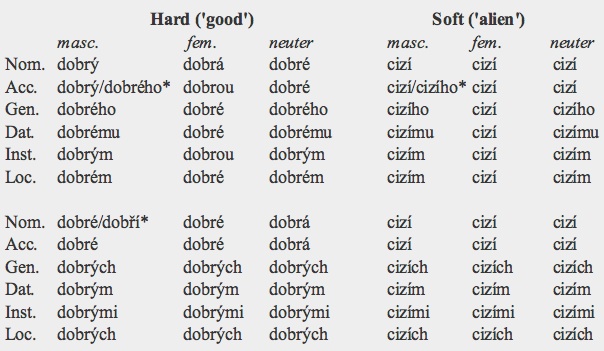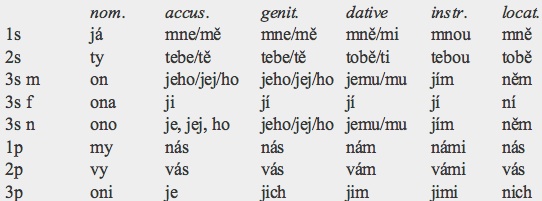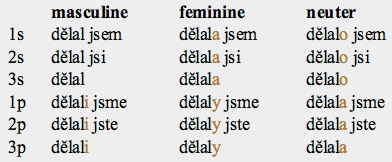An insatiable appetite for ancient and modern tongues


Classification: Indo-European, Slavic, West Slavic. Czech is related to Slovak, Polish, and Sorbian (in eastern Germany). It is usually understood by Slovak speakers.
Overview. The regions of Bohemia and Moravia, that are the core of the modern Czech Republic, were settled successively by Celtic, Germanic, and Slavic tribes. The latter reached these areas around the 6th-7th centuries C.E., but the written tradition there began only in the ninth century, with the arrival of Saints Cyril and Methodius to the kingdom of Great Moravia where they prepared Old Church Slavonic translations of religious texts in an alphabet created by them.
Czech emerged as a distinctive language in the 11-12th centuries and acquired its modern shape with the translation of the Bible in 1593. Its nominal morphology is quite conservative, having retained much of the complexity of the proto-language, namely a seven case system and three numbers. Czech has been greatly influenced by German and to a lesser degree by Hungarian and Slovak. Like other West Slavic languages, it is written with a Latin-derived script and not with the Cyrillic script current in East Slavic.
Distribution and Speakers. Czech is spoken in the regions of Bohemia, Moravia and southwestern Silesia in the Czech Republic. There are about 10.5 million Czech speakers, the vast majority of them in the Czech Republic. Small minorities exist in some neighboring countries and in USA and Canada.
Status. It is the official language of the Czech Republic. Czech can also be used in all official proceedings in Slovakia. It is also one of the 23 official languages of the European Union.
Varieties. There are four groups of Czech dialects: Bohemian, Hanák (Central Moravian), Moravian-Slovak (south-east Moravia) and Lachian (Silesian). Moravian-Slovak dialects are a transition to Slovak, Lachian dialects are a transition to Polish. The dialect of 16th-17th-centuries Prague is the basis for standard written Czech. There is diglossia between the literary and spoken languages. Colloquial Czech is influenced by German vocabulary and syntax.
Oldest Documents. Czech glosses appeared in Latin and German manuscripts of the 12th century. The earliest continuous texts are hymns written in the late 13th century at the courts of the Přemyslid kings of Bohemia.
Periods
Old Czech (12th-14th c.). From the beginning of the 13th century, the back vowels a/a:, u/u: and o/o: underwent a forward shift to e:/ie, i/i: and e:/ie, respectively. These changes, known in Czech as přehláska (‘umlaut’), contributed greatly to the division between hard and soft declensions.
Middle Czech (15th–16th c.). The 15th-century theologian Jan Hus is credited with the invention of diacritic marks to adapt the Latin alphabet to Czech phonology. The Czech Bible translation of 1593 became a reference point for the written language marking the end of Middle Czech and the birth of Modern Czech.
Modern Czech (16th c.-present). Under the control of the Habsburg dynasty, Czech declined due to the imposition of German. Only in the early 19th century, Czech regained importance and became an official language.
Phonology
Vowels (10). Czech has five short vowels and five long matching ones. Vowel length is phonemic.

It also has diphthongs: ou (in native words), au and eu (in foreign words).
Consonants (25). A striking feature of Czech is the absence of g from the native word stock. The original g changed into a voiced h; now g is, thus, restricted to borrowings. F is also largely confined to loans. Final voiced stops are devoiced (dub [dup]) and voiceless stops may become voiced in consonant clusters (kdo [gdo]). Consonant clusters are numerous and they can include up to four successive consonants.
The voiced affricates [dz] and [dʒ] occur as positional variants of [ts] and [tʃ] before voiced consonants. Czech has a very distinctive phoneme [r̝] produced by simultaneous pronunciation of the dental trill [r] and the voiced palatal fricative [ʒ].

Stress: it falls on the first independent syllable of a word (which may contain stressless proclitics and enclitics).
Script and Orthography
Czech is written with a modified Latin alphabet of 42 letters, though 11 of them have no separate entry in the dictionaries (those highlighted in red). Initially, many sounds were represented by digraphs but the Czech linguist Jan Hus (1373-1415) introduced a system of diacritics which in modified form are still in use today.

-
*long vowels are indicated by an acute accent or a ring.
-
*q, w, x occur in loanwords.
Morphology
-
Nominal. Nouns and adjectives are inflected for gender, number and case.
-
•gender: masculine, neuter, feminine. Masculine gender distinguish animate (humans and other animals) from inanimate nouns.
-
•number: singular, plural. Old Czech had also a dual which survives in nouns referring to paired body parts (treated as anomalous plurals).
-
•case: nominative, vocative, accusative, genitive, dative, instrumental, locative.
-
The vocative case occurs only in singular nouns but not in the plural or in adjectives or pronouns.
-
Each gender has its own group of paradigms according to the noun stem; masculine nouns have different declensions for animate and inanimate. Another distinction is between 'hard' and 'soft' declensions which are determined by the noun ending. Nouns that end in a diacritic consonant (č, ď, ě, ň, ř, ť, ž) or in c, j, e, é, ost, are soft; the others are hard.
-
Nominal declensions are divided thus:
-
a)Masculine nouns. For animate nouns there are hard-stem, hard-stem-a, soft-stem and soft-stem-a declension types. For inanimate nouns, hard and soft-stem types.
-
b)Feminine nouns: hard and soft declensions, a soft mixed type and i-declension.
-
c)Neuter nouns: hard and soft declensions, a long soft declension and a nt-declension.

Declension of masculine nouns is as follows:
-
Dative and locative are identical in the singular except for 'hard' masculine inanimate, and neuter nouns. In the plural, the animacy opposition is expressed only in the existence of a distinctive nominative/vocative plural for masculine animates.

-
•adjectives: are declined according to the number, gender and case of the noun they modify. They have a hard and a soft declension. The hard category includes all adjectives whose nominative singular ends in the vowels ý (masculine), á (feminine), é (neuter). The soft category includes the adjectives whose nominative singular ends in í (for all genders).

-
*animate forms.
-
•pronouns: personal, possessive, demonstrative, interrogative, relative.

-
Personal pronouns occur as full or short forms, and are declined using desinences from both noun and adjective paradigms.
-
They distinguish gender in the 3rd singular; the neuter ono habitually refers to animate beings (a child, an animal) and rarely to an inanimate thing. The 2nd plural can also be used as a formal 2nd singular. The nominative forms are usually dropped because the verb has all the information required, but they may be retained for emphasis.
-
Demonstrative pronouns/adjectives distinguish proximal and distal locations as well as gender. They have the following nominative forms:
-
a) ‘this/that’: ten (masc. sg.), ta (fem. sg.), to (neuter sg.), ti (masc. animate pl.), ty (masc. inanimate pl.), ty (fem. pl.), ta (neuter pl.).
-
b) ‘this’: is formed by adding the suffix -to or the more colloquial -hle to the previous forms.
-
c) ‘that’: is formed by adding the prefix tam- to the previous forms.
-
The interrogative pronouns are: kdo (‘who?’) and co (‘what?’).
-
The relative pronoun is: který (masc.), která (feminine), které (neuter). Replaced in everyday speech by co.
-
•articles: Czech has no articles.
-
Verbal. Czech and Slovak, like Russian, have abandoned a complex tense system in favor of an aspect-based system. Person and number are marked in non-past conjugations while number, person and gender are marked in past and conditional conjugations.
-
•person and number: 1s, 2s, 3s; 1p, 2p, 3p.
-
•aspect: perfective, imperfective. The perfective expresses a completed action and the imperfective an habitual or ongoing action. Usually, non-past conjugation of perfective verbs signals future tense, whereas non-past conjugation of imperfective verbs signals present tense. Perfective and imperfective verbs can be derived by prefixation or suffixation.
-
•tense: non-past, past, imperfective future, conditional present, conditional past (rare).
-
Verbs are divided into five classes regarding how they form the present tense in the 3rd singular. Each class is distinguished by a special infix (ending in a vowel) added after the verb stem and before the personal endings:

-
black: root
-
-
green: infix
-
-
blue: personal ending.
-
When the personal ending begins with a vowel the vowel of the infix is dropped. The 3rd. singular has no personal ending. Personal endings for 1st. singular and 3rd. plural are (partly) specific for each conjugation.

-
The past tense is made with the l-participle (a special participle used only to form compound tenses) followed by the present of být (‘to be’). The auxiliary is omitted in the 3rd person and the participle is inflected for gender and number. For example, the past tense of dělat (‘to make’) is shown in the table.
-
If a subject pronoun is present the order is inverted (e.g., já jsem dělal).
-
The perfective future is expressed by the present tense forms of the perfective verb.
-
The imperfective future is formed by the future tense of být as auxiliary combined with the infinitive of the main verb. Negative forms are made by adding the prefix ne-.
-
The conditional is expressed by a combination of the conjugated auxiliary být, and the l-participle. In the present conditional the present tense of the auxiliary is used, and in the past conditional its past tense.

-
In the examples above dělat is the imperfective form; the perfective form is derived from it by adding the prefix u- (in red).
-
•mood: indicative, imperative.
-
In Slavic studies, the conditional is considered as a mood, but we have treated it as a tense. The imperative has only three forms: 2s dělej, 1p dělejme, 2p dělejte.
-
•voice: active and passive. In the colloquial language the passive voice may be expressed by inverting the order of subject and object:
-
Petr zabil Pavla. Peter killed Paul.
-
Pavla zabil Petr. Paul was killed by Peter.
-
There is no ambiguity as Pavl is marked in the accusative case (by the suffix -a) as the patient of the action.
-
Otherwise, the passive voice may be expressed by using a passive participle of a transitive verb with být as auxiliary. Impersonal constructions, where no agent is named, employ the particle se:
-
Cibule se tam dá nejdrív.
-
onion particle in put first.
-
The onion is put in first.
-
•non-finite forms: infinitive, imperfective and perfective gerunds, present active participle, l-participle, passive participle.
-
‣The infinitive marker is -t.
-
‣The gerunds are used in formal and literary Czech; they agree with the subject of the main clause.
-
‣The present active participle is formed only by imperfective verbs by adding -i to the feminine/neuter gerund; its main function is to condense relative clauses but many participles have become adjectives.
-
‣The l-participle is formed by changing the final t of the infinitive for an -l; it contributes to form the past tense and the conditional.
-
‣The passive participle has short and long forms. The more colloquial long forms end in -ný or, less frequently, -tý; they function as adjectives used attributively or predicatively. Short forms derive from long ones by dropping the final ý; they are employed to form the periphrastic passive.
Syntax
Word order is essentially free but the underlying one is Subject-Verb-Object. The element carrying new information or most emphasis occupies the last position in the sentence. The order of enclitics, namely stressless auxiliary verbs and pronouns, is strict. They occupy the second slot in the clause, after the first stressed word, and within this slot:
-
1. auxiliary verb in the past tense or conditional
-
2. reflexive pronoun
-
3. dative pronoun
-
4. object pronoun
-
5. adverb or particle
Czech is a pro-drop language i.e., subject pronouns are usually dropped because the verb has all the information required about person and number; they are only used for emphasis.
Lexicon
About 15 % of all Czech words are borrowings, the most ancient from Old Church Slavonic. Later, Latin became an important source for religious and administrative terms. German contributed many technical words. During the 19th century Czech revival loans came, mainly, from other Slavic languages. Since World War II, Russian and English are the main contributors.
Basic Vocabulary
one: jeden, jedna, jedno
two: dva, dvě
three: tři
four: čtyři
five: pĕt
six: šest
seven: sedm
eight: osm
nine: devět
ten: deset
hundred: sto
father: otec, tata
mother: matka, mati, mama
brother: bratr
sister: sestra
son: syn
daughter: dcera
head: hlava
face: tvář
eye: oko
hand: ruka
foot: noha
heart: srdce
tongue: jazyk
Key Literary Works (forthcoming)
-
© 2013 Alejandro Gutman and Beatriz Avanzati
Further Reading
-
-'Czech'. D. Short. In The Slavonic Languages, 455-532. B. Comrie & G. G. Corbett (eds). Routledge (1993).
-
-'Czech and Slovak'. D. Short. In The World's Major Languages, 305-329. B. Comrie (ed). Routledge (2009).
-
-Czech. An Essential Grammar. J. Naughton. Routledge (2005).
Czech

Address comments and questions to: gutman37@yahoo.com
MAIN LANGUAGE FAMILIES
LANGUAGE AREAS
Languages of Ethiopia & Eritrea
LANGUAGES by COUNTRY
LANGUAGE MAPS
-
• America
-
• Asia
-
Countries & Regions
-
-
Families
-
• Europe
-
• Oceania